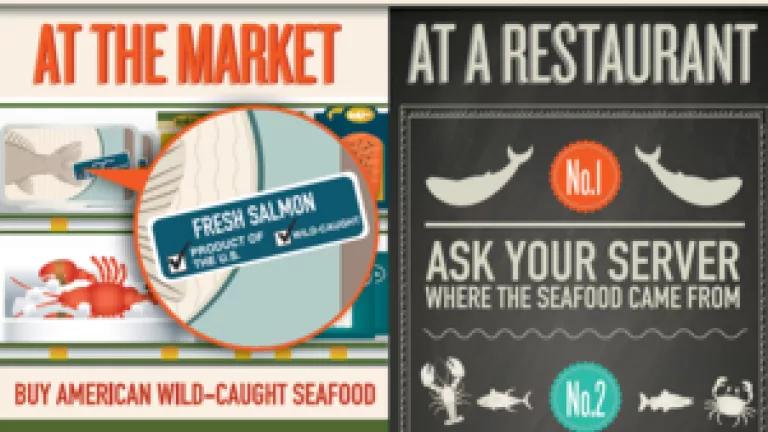
On October 1, 2013, a female humpback whale washed up dead on a Long Island beach. Its 20-ton body, discovered by an early-morning surfer, bore signs of trauma. The cause of death, although it’s being investigated by the federal government, is no great mystery. According to researchers on the scene, the whale’s wounds were consistent with injuries from fishing nets.
Every year, 650,000 whales, dolphins, porpoises, seals, sea lions, and other marine mammals are killed or injured by fishing operations around the globe. Most of this harm occurs outside U.S. waters. In the United States, fishermen are taking steps to protect marine mammals from harm, but other countries lag far behind in using similar protections. And, as detailed in a new report from NRDC, these countries illegally export millions of tons of seafood—worth billions of dollars—into the United States. American consumers are unknowingly eating the catch—including lobster, tuna, even fish sticks—that is driving some species of whales, dolphins, and other marine mammals toward extinction.
When fishing gear scoops up, hooks, entangles, or otherwise harms another creature not destined for market, it’s called bycatch: an innocuous term for a senseless waste of marine life. Bycatch occurs all over the world’s oceans on a massive scale. When I spent time with fishermen in the Gulf of Mexico after the Deepwater Horizon disaster, they told me they would toss back 10 pounds of fish, or more, for every pound of shrimp they caught. Most of this fish is dead or dying when it gets back in the water. Bycatch is more than just waste—for some marine mammals, bycatch is the main reason their species is headed toward extinction.
North American right whales, which rank among the most endangered whales on the planet, are prone to getting tangled in the long ropes of crab and lobster pots, or stuck in nets meant to trap fish like hake and halibut in the North Atlantic. With an estimated 500 individuals left, the untimely loss of even a single whale threatens the survival of the species. Every year, one or two right whales die from encounters with fishing gear. In Maine, lobstermen use special breakaway ropes that can help an entangled whale free itself. Canadian lobstermen, however, are not required to do so. The same whale that escapes a Maine lobsterpot might perish in a Canadian trap set just a few miles away.
In the Mediterranean, endangered sperm whales and dolphins get tangled in massive driftnets set for tuna, as bans on driftnets are poorly enforced. Thousands of spinner dolphins in the Indian Ocean are killed annually by fishing. The New Zealand sea lion, which gets trapped by squid trawlers operating near its breeding grounds, will be functionally extinct by 2035, scientists say, unless bycatch is reduced.
Massive European and Chinese trawlers haul in sardines, herring and mackerel off the coast of West Africa, where fishing is almost entirely unregulated. What happens on these boats is anyone’s guess, but international fishing experts conjecture that dolphins are being killed in the process. Trawlers sometimes purposely target dolphins in order to locate their prey.
In most cases, the countries behind these harmful fishing operations do not lack the resources to protect marine mammals. What they lack is an incentive. As long as they’re able to fish with impunity and export their seafood to the United States, they will continue to do so.
Bycatch is still a problem in the United States, but we have mechanisms in place to address it, and have done so with some success. Over the past two decades, bycatch levels in the United States have dropped about 30 percent, thanks to adjustments to fishing gear and a shift to more sustainable management strategies. In New England, mild acoustic “pingers” warn harbor porpoises away from nets. And when bycatch rates reach a certain level in a particular fishery, it can trigger the closure of fishing in some areas or for certain time periods.
Measures like these have been proven to save the lives of whales and other marine mammals, and make fishing more efficient. But other nations haven’t been playing by our rules. According to U.S. law—specifically, the international bycatch provision of the Marine Mammal Protection Act—imported fish is supposed to meet U.S. standards for bycatch reduction. In practice, the law is not enforced, and countries continue to bring in their seafood, often caught at great cost to marine mammals, to sell alongside American-caught fish.
The U.S. government is in the process of figuring out how to enforce this provision of the Marine Mammal Protection Act, which will level the playing field for American fishermen as well as protect consumers who think they’re buying responsibly-caught fish. In the meantime, if you’re seeking seafood caught in a way that reduces risks to whales, dolphins, and other marine mammals, buy American. Fish caught in U.S. waters are subject to bycatch rules, while fish from foreign waters—even those that bear sustainable certifications—do not meet U.S. standards for protecting marine mammals.
We have the gear and the know-how to reduce the needless harm of bycatch. Any nation that wants to sell its seafood alongside our own should have to make similar efforts to reduce harm to marine mammals instead of driving them toward extinction. Help end the deadly catch of marine mammals.
